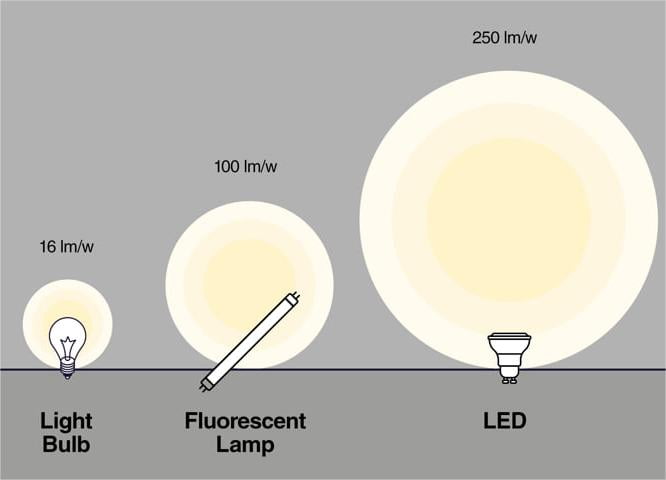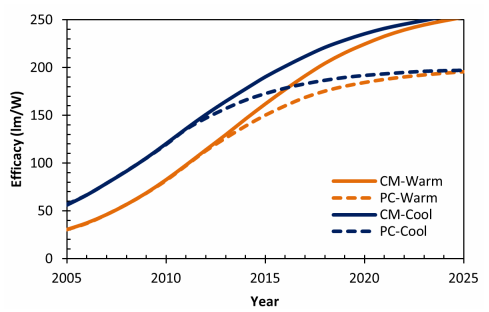Understanding Watts and Lumens: How to choose the right brightness light fixture for your project
Lumens vs watts
What does watts mean in light bulbs?
Watts (symbol: W) is a unit of power, measuring the amount of energy consumed. When we pay our electricity bill, we are paying for the watts we use. Since we have traditionally used incandescent light bulbs, we are accustomed to using watts as a unit of brightness, but this is incorrect. The measure of the brightness of a light fixture is lumens, not watts.

Understanding Lumens
Lumens are the measurement of visible light energy. The higher the number of lumens, the brighter the light. Lighting fixtures used for illumination are usually labeled with their light output (in lumens), which is legally required in many jurisdictions.
Therefore, when we choose the brightness of the lamp, we only need to look for the lumen value on the package.
Understand the conversion between lumens and watts to find the right brightness
If a road contractor asks if we have a 100W solar street light, it is difficult to determine the requirement for how many lumens of solar LED street light they need. To understand the relationship between them clearly, we need to understand Luminous Efficacy (lumens per watt).
This measure indicates how efficiently a light source converts energy (watts) into light (lumens).
Luminous efficacy (lm/W) = lumens (lm)/Watt(W)

Luminous efficacy of different lamps with the same watt
Luminous efficacy of different lamps
Based on a 2013 report from energy.gov in the United States, there are LED package standards established at 266 lm/W and PC-LEDs achieving over 130 lm/W, with a successful prediction that by 2024 the luminous efficacy of LEDs will exceed 200 lm/W, showing the importance and expectations for future LED lighting.

As of 2024, LED technology can indeed achieve a theoretical 230 lm/W (actual usage tested at 200 lm/W). Due to variations in specifications among manufacturers and market supply-demand issues, there are still many LEDs on the market ranging from 130 lm/W to 190 lm/W. Therefore, when selecting the brightness of a light fixture, it is essential to pay attention to lumens.
Incandescent technology typically produces 12-18 lumens per watt, while halogen technology usually produces 10-20 lumens per watt.
Therefore, for the same wattage, the brightness of LED bulbs is approximately 10-14 times that of incandescent bulbs and about 10 times that of halogen bulbs. You can roughly refer to this indicator when choosing light fixtures.
lumens to watts conversion chart (in led light Luminous efficacy 130 lm/W)
| Lumens | Incandescent Watts | Halogen Watts | LED Watts |
| 100 | 7 | 6 | 0.77 |
| 375 | 25 | 20 | 2.9 |
| 450 | 30 | 25 | 3.5 |
| 800 | 60 | 45 | 6 |
| 1100 | 75 | 60 | 8.5 |
Lumen to watt chat (In different led Luminous efficacy)
| Lumens to watt | Luminous efficacy(lm/W) | |||
| Lumens | 130 lm/W | 150 lm/W | 180 lm/W | 200 lm/W |
| 100 lm | 0.8w | 0.7w | 0.6w | 0.5w |
| 500 lm | 4w | 3w | 3w | 3w |
| 1000 lm | 8w | 7w | 6w | 5w |
| 2000 lm | 15w | 13w | 11w | 10w |
| 3000 lm | 23w | 20w | 17w | 15w |
| 4000 lm | 31w | 27w | 22w | 20w |
| 6000 lm | 46w | 40w | 33w | 30w |
| 8000 lm | 62w | 53w | 44w | 40w |
| 10000 lm | 77w | 67w | 56w | 50w |
| 15000 lm | 115w | 100w | 83w | 75w |
| 20000 lm | 154w | 133w | 111w | 100w |
How to verify the reliability of Luminous Efficacy
Rely on the manufacturer’s provided Luminous Efficacy Test Report.
How do I know how many lumens I need?
Lumen calculator
You can use a lumen calculator to determine this, at https://www.omnicalculator.com/everyday-life/lighting
How many lumens are needed for outdoor street lights?
The number of lumens required for street lights depends on several factors, such as the height of the light pole, the width of the road, and the amount of ambient light available. To determine the appropriate lumen output, recommended illumination levels for different types of roads need to be considered.
Generally, residential streets require around 5,000 to 12,000 lumens per light, while main roads and highways may require higher lumen outputs, typically needing 10,000 to 15,000 lumens to ensure safety.
Reference Standards for street lights Pole Height and Lumen
- 6m Height:6000Lumens
- 8m Height:8000Lumens
- 10m Height:10000Lumens
- 12m Height:12000Lumens
- 14m Height:15000Lumens
- 16m Height:18000Lumens
- 20m Height:25000Lumens
For guidance on how to choose the light pole height, please refer to the article:HOW TO CALCULATE THE HEIGHT AND DISTANCE OF SOLAR STREET LIGHT POLE?
How many lumens are needed for indoor environments
- Workspace or garage: 8,000 to 10,000 lumens
- Kitchen work areas: 7,000 to 8,000 lumens
- Bathroom: 7,000 to 8,000 lumens
- Home office: 6,000 to 8,000 lumens
- Dining room: 3,000 to 4,000 lumens
- Kitchen: 3,000 to 4,000 lumens
- Dining room: 3,000 to 4,000 lumens
- Living room: 1,000 to 2,000 lumens
- Bedroom: 1,000 to 2,000 lumens
- Hallway: 500 to 1,000 lumens
These are general guidelines that apply to most spaces; however, they may not be applicable to all scenarios. Rooms with darker walls and particularly high ceilings may require additional lumens to achieve the desired effect.
Finally, we recommend you read this article to learn about Light measurement for solar street lighting systems:https://luxmanlight.com/are-solar-street-lights-bright-enough/
Sources of reference
https://en.wikipedia.org/wiki/Lumen_(unit)
https://en.wikipedia.org/wiki/Watt


